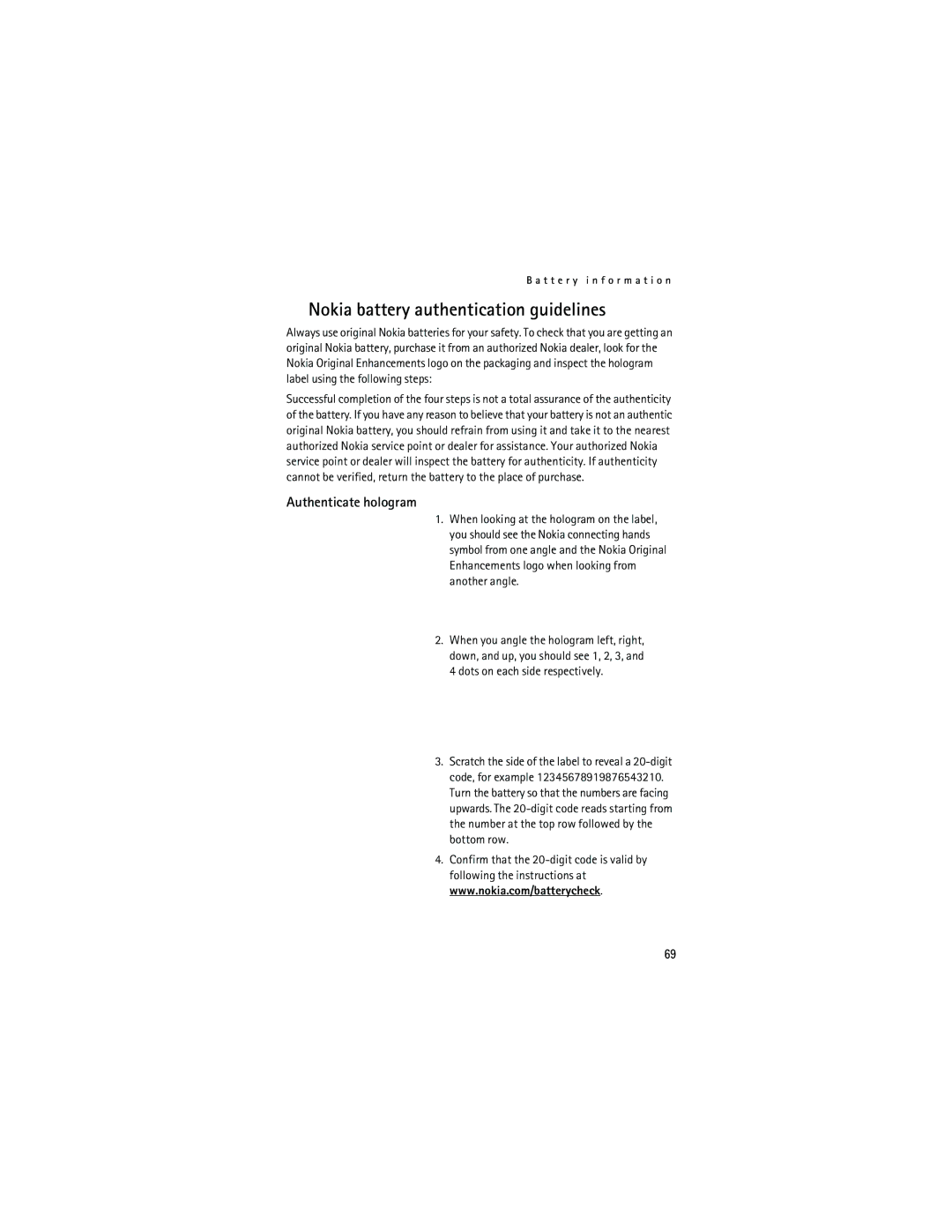User Guide
Nokia 6016i User Guide
Part No , Issue No Copyright 2005 Nokia. All rights reserved
Table of contents
Only qualified personnel may install or repair this product
For your safety
Your phone is not water-resistant. Keep it dry
Backup Copies
Welcome
Network Services
About your device
Get help
Shared memory
Find your phone label
Contact Nokia
Updates Accessibility solutions
Nokia
Microphone
Phone at a glance
Charger port
Start screen
Indicators and icons
Quick keys
Phone menus
Get the most out of this guide
See Location info sharing, p
Scroll method
In-phone help
Change the battery
Set up your phone
Antenna
Remove the back cover
Remove the battery
Replace the battery
Replace the back cover
Turn your phone on or off
Charge the battery
Connect the headset
Make a call
Answer calls
Use the loudspeaker
Adjust the earpiece volume
Answer a call with the keypad locked
Options during a call
Unlock the keypad
Keyguard
Lock the keypad
Select Menu then press * within 2 seconds
Text Abc
Standard mode
Text entry
Numbers
Activate or deactivate
Predictive text input
Punctuation and special characters
Text entry
View received calls
Call log
View dialed numbers
Call times
View duration of minibrowser
View missed calls
Delete call registers
View duration of calls
Write and send
Messages
Text messages
Options
Read messages
Templates
Change message settings
Change sending options
Save voice mailbox number
Call and setup your voice mail
Voice messages
Listen to your voice messages
Write down voice mailbox process
Setup voice mail with dialing codes
Insert dialing codes
Save messages to folders
Minibrowser messages
Message folders
View saved messages
Delete a single message
Delete messages
All messages in a folder
View the contacts list
Select an item to activate the feature or enter its submenu
Contacts
Search
Edit contacts list entries
Add new contacts
Add numbers to a contact
Edit phone number
Mail address entry
Delete contacts list entries
Configure settings
Set up 1-touch dialing
Edit Web address
Delete 1-touch dialing numbers
Set up voice tags
Change 1-touch dialing numbers
Assign a voice tag to an entry
Dial a number
Caller groups
Voice tag options
Options
Setup a caller group
Send and receive contacts business cards
Send a business card
Folders
Gallery
Open the gallery
Gallery downloads
Activate a profile
Settings
Profiles
Customize a profile
Activate a voice command
Voice commands
Assign a voice tag to a command
Voice dialing
Location info sharing
Call settings
Anykey answer
Touch dialing
Auto-update of service
Automatic redial
Minibrowser confirmation
Make calls
Call summary
Save information
Enter your security code, and select OK. See Lock code, p
Automatic keyguard
Phone settings
Phone language
Touch tones
Help text activation
Display settings
Welcome note
Wallpaper
Banner
Screen saver timeout
Banner is a network service. See Network Services, p
Display brightness
Clock
Time and date settings
Set the auto-update of date and time
Date
Enhancement settings
Tone settings
Phone details
Hands-free
Set up the TTY/TDD profile
Headset
Loopset
Charger
Security settings
Activate or deactivate phone lock
Lock code
Allow numbers when phone locked
Call the allowed phone number
Call forwarding
Restrict calls
Voice privacy
Activate
Network
Store a feature code
Cancel
Select your own phone number
Mode
Restore factory settings
Roaming options
Select OK, if necessary, to confirm the activation
Set the alarm tone
Alarm clock
Set an alarm
Alarm conditions
Open
Turn an alarm off
Calendar
Go to a date
Send a note
View notes day view
Options while viewing a list of notes
To view a highlighted note, select Options View
Voice recorder
Record speech or sound
Currency converter
Calculator
Enter the exchange rate, and select OK
Countdown timer
Stopwatch
Operation note
Measure split time
Measure lap time
Save the split time
Options
Minibrowser
Mobile Internet access
Minibrowser is a network service. See Network Services, p
Sign on to the mobile Internet
Receive a call while online
Navigate the mobile Internet
Phone keys
Make an emergency call while online
Games
Game settings
Enter the submenu, and select other settings
Play a game
Unlock the keypad
Keyguard
Lock the keypad
Standby mode, select Menu then press * within two seconds
PC Connectivity
Remember to make backup copies of all important data
PC Suite
Enhancements
Standard 1070 mAh Li-Ion Battery BL-6C
Travel Charger ACP-12U Mobile Charger LCH-12
Battery information
Charging and discharging
Nokia battery authentication guidelines
Authenticate hologram
What if your battery is not authentic?
Care and maintenance
Use chargers indoors
Operating environment
Additional safety information
Medical devices
Vehicles
Potentially explosive environments
Emergency calls
To make an emergency call
Certification information SAR
Charging times
Battery information
Technical information
Talk and standby times
Patent information
Index
Countdown timer 59 currency converter 58 customer care
Enhancement settings 47 handsfree 48 headset
Emergency calls
Message folders 28 messages Delete
Adjusting Using the loudspeaker

